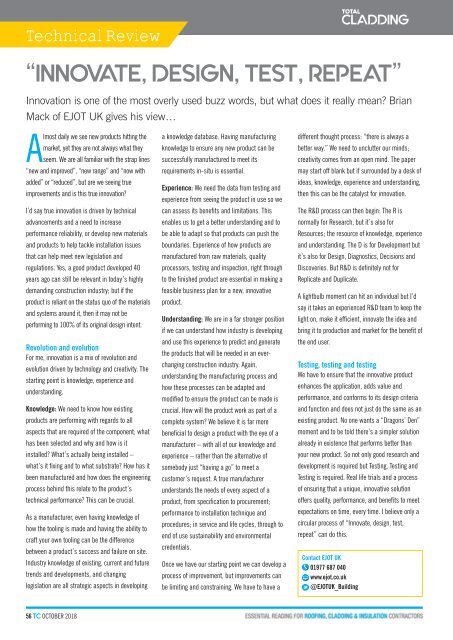October 2018
You also want an ePaper? Increase the reach of your titles
YUMPU automatically turns print PDFs into web optimized ePapers that Google loves.
Technical Review<br />
“INNOVATE, DESIGN, TEST, REPEAT”<br />
Innovation is one of the most overly used buzz words, but what does it really mean? Brian<br />
Mack of EJOT UK gives his view…<br />
Almost daily we see new products hitting the<br />
market, yet they are not always what they<br />
seem. We are all familiar with the strap lines<br />
“new and improved”, “new range” and “now with<br />
added” or “reduced”, but are we seeing true<br />
improvements and is this true innovation?<br />
I’d say true innovation is driven by technical<br />
advancements and a need to increase<br />
performance reliability, or develop new materials<br />
and products to help tackle installation issues<br />
that can help meet new legislation and<br />
regulations. Yes, a good product developed 40<br />
years ago can still be relevant in today’s highly<br />
demanding construction industry; but if the<br />
product is reliant on the status quo of the materials<br />
and systems around it, then it may not be<br />
performing to 100% of its original design intent.<br />
Revolution and evolution<br />
For me, innovation is a mix of revolution and<br />
evolution driven by technology and creativity. The<br />
starting point is knowledge, experience and<br />
understanding.<br />
Knowledge: We need to know how existing<br />
products are performing with regards to all<br />
aspects that are required of the component; what<br />
has been selected and why and how is it<br />
installed? What’s actually being installed –<br />
what’s it fixing and to what substrate? How has it<br />
been manufactured and how does the engineering<br />
process behind this relate to the product’s<br />
technical performance? This can be crucial.<br />
As a manufacturer, even having knowledge of<br />
how the tooling is made and having the ability to<br />
craft your own tooling can be the difference<br />
between a product’s success and failure on site.<br />
Industry knowledge of existing, current and future<br />
trends and developments, and changing<br />
legislation are all strategic aspects in developing<br />
a knowledge database. Having manufacturing<br />
knowledge to ensure any new product can be<br />
successfully manufactured to meet its<br />
requirements in-situ is essential.<br />
Experience: We need the data from testing and<br />
experience from seeing the product in use so we<br />
can assess its benefits and limitations. This<br />
enables us to get a better understanding and to<br />
be able to adapt so that products can push the<br />
boundaries. Experience of how products are<br />
manufactured from raw materials, quality<br />
processors, testing and inspection, right through<br />
to the finished product are essential in making a<br />
feasible business plan for a new, innovative<br />
product.<br />
Understanding: We are in a far stronger position<br />
if we can understand how industry is developing<br />
and use this experience to predict and generate<br />
the products that will be needed in an everchanging<br />
construction industry. Again,<br />
understanding the manufacturing process and<br />
how these processes can be adapted and<br />
modified to ensure the product can be made is<br />
crucial. How will the product work as part of a<br />
complete system? We believe it is far more<br />
beneficial to design a product with the eye of a<br />
manufacturer – with all of our knowledge and<br />
experience – rather than the alternative of<br />
somebody just “having a go” to meet a<br />
customer’s request. A true manufacturer<br />
understands the needs of every aspect of a<br />
product, from specification to procurement;<br />
performance to installation technique and<br />
procedures; in service and life cycles, through to<br />
end of use sustainability and environmental<br />
credentials.<br />
Once we have our starting point we can develop a<br />
process of improvement, but improvements can<br />
be limiting and constraining. We have to have a<br />
different thought process: “there is always a<br />
better way.” We need to unclutter our minds;<br />
creativity comes from an open mind. The paper<br />
may start off blank but if surrounded by a desk of<br />
ideas, knowledge, experience and understanding,<br />
then this can be the catalyst for innovation.<br />
The R&D process can then begin: The R is<br />
normally for Research, but it’s also for<br />
Resources; the resource of knowledge, experience<br />
and understanding. The D is for Development but<br />
it’s also for Design, Diagnostics, Decisions and<br />
Discoveries. But R&D is definitely not for<br />
Replicate and Duplicate.<br />
A lightbulb moment can hit an individual but I’d<br />
say it takes an experienced R&D team to keep the<br />
light on, make it efficient, innovate the idea and<br />
bring it to production and market for the benefit of<br />
the end user.<br />
Testing, testing and testing<br />
We have to ensure that the innovative product<br />
enhances the application, adds value and<br />
performance, and conforms to its design criteria<br />
and function and does not just do the same as an<br />
existing product. No one wants a “Dragons’ Den”<br />
moment and to be told there’s a simpler solution<br />
already in existence that performs better than<br />
your new product. So not only good research and<br />
development is required but Testing, Testing and<br />
Testing is required. Real life trials and a process<br />
of ensuring that a unique, innovative solution<br />
offers quality, performance, and benefits to meet<br />
expectations on time, every time. I believe only a<br />
circular process of “Innovate, design, test,<br />
repeat” can do this.<br />
Contact EJOT UK<br />
01977 687 040<br />
www.ejot.co.uk<br />
@EJOTUK_Building<br />
56 TC OCTOBER <strong>2018</strong>

















